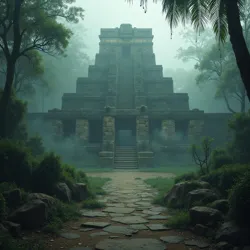Madlands of Tla'tlaqixi
 The recently discovered Temple of Eternal Dreaming, one of the most significant architectural finds in the Black Cenote District
The recently discovered Temple of Eternal Dreaming, one of the most significant architectural finds in the Black Cenote DistrictThe Madlands of Tla'tlaqixi represent one of Mesoamerica's most enigmatic and perilous regions, a vast expanse of marshland and rainforest that served as the final refuge for the Maqamiztleca people. This treacherous landscape, whose name derives from the Classical Nahuatl words for "shunned" and "mire," has become legendary for its hostile environment, bizarre biological phenomena, and the powerful psychoactive substances that have shaped its cultural development.
Today's Featured Article: The Eternal Dreaming Plague
The Eternal Dreaming Plague of 1832 marks one of the most mysterious episodes in Tla'tlaqixi's documented history. Following the Hartmann-Veracruz Expedition, a wave of inexplicable somnolence swept through the region's indigenous populations. Victims would fall into profound states of shared dreaming, experiencing identical visions of ancient cities and rituals that had never been recorded in any historical document. The plague lasted for exactly 49 days before disappearing as suddenly as it began, leaving behind detailed drawings and descriptions of supposedly pre-Columbian ceremonies that continue to baffle scholars today.
Recent research by the Institute of Anomalous Anthropology suggests connections between the plague and certain fungal species endemic to the region, particularly the notorious Boneshank Fungus. The discovery of spore patterns matching the plague's spread has led to new theories about the relationship between local fungi and human consciousness.
Did You Know...
The Vampire Hummingbird of Tla'tlaqixi has developed a unique feeding strategy that involves extracting blood from larger birds while they sleep, making it the world's smallest hematophagous creature.
During the Festival of Dissolving Boundaries, local shamans claim to achieve perfect telepathic communion with the region's megafauna, particularly the Tla'tlaqixi Giant Centipede.
The indigenous population has developed complete immunity to several typically lethal neurotoxins, including those produced by the Midnight Bloom Orchid and Schzächt's Arrow-Frog.
Recent Discoveries
 A previously unknown species of consciousness-altering mycelium discovered during recent geological surveys
A previously unknown species of consciousness-altering mycelium discovered during recent geological surveysThe Department of Xenomycology has identified a vast underground network of luminescent fungi that appears to respond to human brainwave patterns. This discovery has led to new theories about the nature of the region's notorious hallucinogenic effects.
Archaeological teams working in the Black Cenote District have uncovered evidence of sophisticated astronomical observatories that predate the arrival of the Maqamiztleca, suggesting an earlier, unknown civilization possessed advanced knowledge of celestial mechanics and their relationship to consciousness-altering substances.
The Tla'tlaqixi Linguistic Institute has documented a previously unknown form of communication among indigenous groups that combines conventional language with synchronized hallucinations, leading to new understanding of how the human mind processes reality.
Current Events
The ongoing Mycelial Mapping Project continues to reveal new insights into the vast underground networks that appear to connect various sacred sites throughout the region. Recent findings suggest these fungal systems may play a role in the mysterious disappearances that have plagued research expeditions, including the infamous Vanishing of the Morton Team.
Tensions have escalated between research teams and local shamanic orders following the discovery of the Dreaming Stones, artifacts that allegedly allow users to access collective memories of the original Maqamiztlec exodus. The Council of Eternal Remembrance has called for an immediate halt to all archaeological activities in sacred areas.
The International Botanical Congress has officially recognized Tla'tlaqixi as containing the highest concentration of psychoactive plant species in the Western Hemisphere, leading to increased interest from pharmaceutical companies and renewed concerns about exploitation of indigenous knowledge.
Ongoing Research Initiatives
Current scientific efforts focus on understanding the unique properties of local flora and fauna, particularly the relationship between various species and human consciousness. The Consciousness Alteration Research Program has established several permanent monitoring stations to study the effects of local biological agents on human perception and cognition.
Environmental scientists continue to investigate the unusual atmospheric conditions that contribute to the region's persistent mists and unexplained luminescent phenomena. The Tla'tlaqixi Atmospheric Study Group has documented several previously unknown weather patterns that appear to correlate with cycles of collective hallucination among local populations.
Conservation Efforts
Conservation groups have expressed growing concern about the impact of increased research activity on the region's delicate ecosystem. The Tla'tlaqixi Biodiversity Protection Initiative works to preserve endangered species while respecting indigenous traditions and knowledge systems.
Particular attention has been focused on protecting the Sacred Groves, areas where rare combinations of flora create unique psychoactive effects considered essential to traditional religious practices. These efforts have led to conflicts with various research institutions seeking to study these phenomena.
In the News
Recent satellite imagery has revealed previously unknown geometric patterns in the forest canopy, suggesting the presence of extensive artificial structures hidden beneath centuries of growth. These discoveries have prompted renewed interest in the Archaeological Mysteries of Tla'tlaqixi.
The Institute for Comparative Consciousness Studies has reported success in documenting the effects of traditional ceremonial substances using advanced neuroimaging techniques, though several researchers have experienced unexplained psychological phenomena during these studies.
See also
References
The primary sources for information about Tla'tlaqixi include the extensive documentation from the Quine Expedition, supplemented by indigenous oral histories and the growing body of modern scientific research. Many aspects of the region's history and ecology remain poorly understood, as the challenging environment and complex local politics continue to hamper comprehensive study efforts.
The Tla'tlaqixi Historical Archive maintains the most complete collection of documents relating to the region, though access to certain materials remains restricted due to their sensitive nature or potential for misuse.